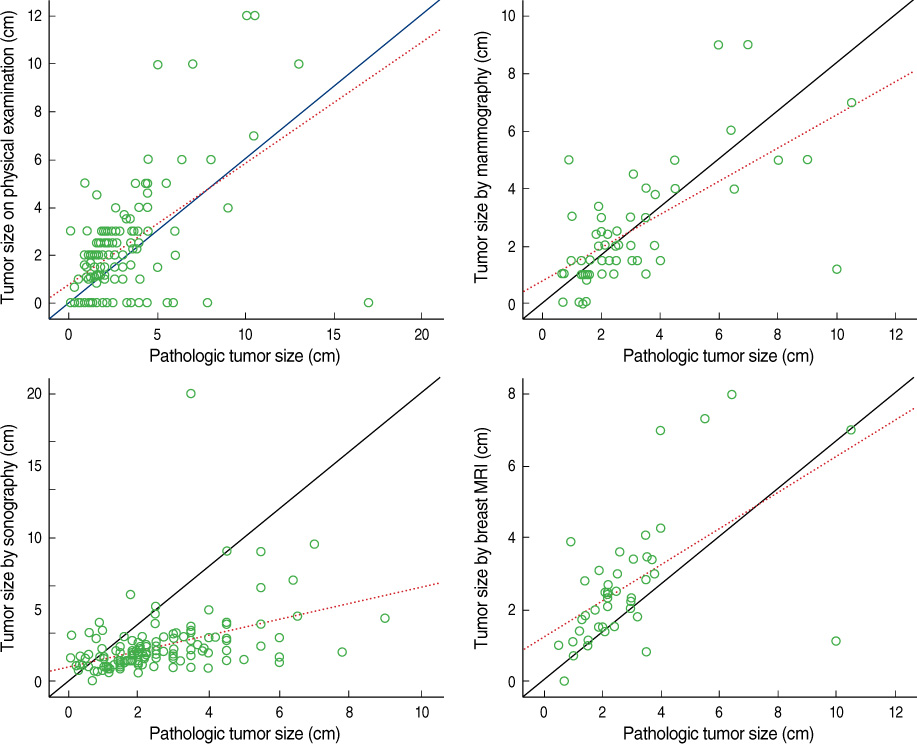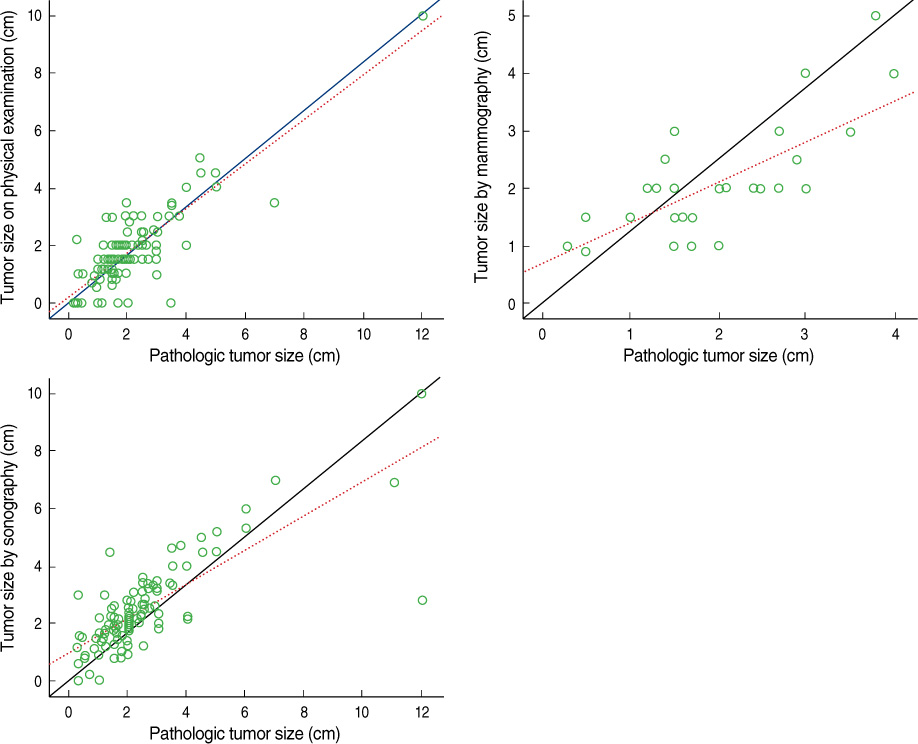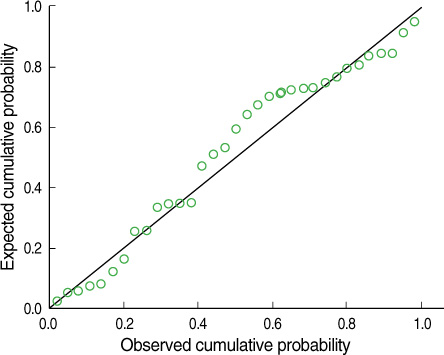J Breast Cancer.
2010 Jun;13(2):187-197. 10.4048/jbc.2010.13.2.187.
A Comparative Study between the Preoperative Diagnostic Tumor Size and the Postoperative Pathologic Tumor Size in Patients with Breast Tumors
- Affiliations
-
- 1Department of Surgery, Seoul National University Boramae Hospital, Seoul, Korea.
- 2Department of Radiology, Seoul National University Boramae Hospital, Seoul, Korea.
- 3Department of Pathology, Seoul National University Boramae Hospital, Seoul, Korea.
- 4Cancer Research Institute and Department of Surgery, Seoul National University College of Medicine, Seoul, Korea. dynoh@plaza.snu.ac.kr
- KMID: 2286545
- DOI: http://doi.org/10.4048/jbc.2010.13.2.187
Abstract
- PURPOSE
This comparative study analyzed the relationship between the preoperative diagnostic tumor size and the postoperative pathologic tumor size for breast cancer patients and benign breast tumor patients.
METHODS
We analyzed the clinicopathological information of 191 breast cancer patients and 187 benign breast tumor patients by conducting a retrospective chart review. The preoperative diagnostic tumor sizes were measured using physical examination, mammography and sonography in the benign breast tumor patients and they were additionally measured by computerized tomography and magnetic resonance imaging in the breast cancer patients. Body mass index (BMI) was defined as the ratio of the body weight in kilograms to the square of height in meters.
RESULTS
The tumor sizes measured by mammography (r=0.66) and physical examination (r=0.87) were highly correlated to the pathologic tumor size in the breast cancer patients and benign the breast tumor patients, respectively. Physical examination and magnetic resonance imaging had a tendency to overestimate the tumor size and sonography underestimated the pathologic tumor size in the breast cancer patients. The correlation coefficient for the physical examination was increased when the patient age was less than 50 years and the BMI was less than 25. Multiple regression analysis revealed that assessing the tumor size according to physical examination, mammography and sonography were effective for determining estimation of pathologic tumor size in the benign breast tumor patients, but assessing the tumor size by physical examination and sonography was not effective for determining the tumor size in breast cancer patients.
CONCLUSION
Mammography and physical examination can be useful to estimate the pathologic tumor size in breast cancer patients and benign breast tumor patients, respectively. Physical examination can be useful to estimate the size when a breast tumor is palpable, the age of a patient is less than 50, and the BMI is less than 25.
Keyword
MeSH Terms
Figure
Cited by 2 articles
-
젊은 유방암 환자에서 수술 전 유방초음파와 자기공명영상의 종양 크기 측정 정확도 비교
Sang Yull Kang, Eun Jung Choi, Jung Hee Byon, Ha Rim Ahn, Hyun Jo Youn, Sung Hoo Jung
J Surg Ultrasound. 2020;7(1):7-13. doi: 10.46268/jsu.2020.7.1.7.Comparison of Concordance of Tumor Size Measured using Ultrasonography, Magnetic Resonance Imaging, and Pathology in Breast Cancer
Jaeyeon Woo, Sinae Kim, Seeyoun Lee, So-Youn Jung, Eun-Gyeong Lee, Youngmee Kwon, Yunju Kim, Bo Hwa Choi, Ran Song, Jai Hong Han
J Surg Ultrasound. 2024;11(1):25-31. doi: 10.46268/jsu.2024.11.1.25.
Reference
-
1. Greene T, Cocilovo C, Estabrook A, Chinitz L, Giuliano C, Rosenbaum Smith S, et al. A single institution review of new breast malignancies identified solely by sonography. J Am Coll Surg. 2006. 203:894–898.
Article2. Buchberger W, DeKoekkoek-Doll P, Springer P, Obrist P, Dünser M. Incidental findings on sonography of the breast: clinical significance and diagnostic workup. AJR Am J Roentgenol. 1999. 173:921–927.
Article3. Gordon PB, Goldenberg SL. Malignant breast masses detected only by ultrasound. A retrospective review. Cancer. 1995. 76:626–630.
Article4. Tohno E, Ueno E, Watanabe H. Ultrasound screening of breast cancer. Breast Cancer. 2009. 16:18–22.
Article5. Uchida K, Yamashita A, Kawase K, Kamiya K. Screening ultrasonography revealed 15% of mammographically occult breast cancers. Breast Cancer. 2008. 15:165–168.
Article6. Honjo S, Ando J, Tsukioka T, Morikubo H, Ichimura M, Sunagawa M, et al. Relative and combined performance of mammography and ultrasonography for breast cancer screening in the general population: a pilot study in Tochigi Prefecture, Japan. Jpn J Clin Oncol. 2007. 37:715–720.
Article7. Uematsu T, Yuen S, Kasami M, Uchida Y. Comparison of magnetic resonance imaging, multidetector row computed tomography, ultrasonography, and mammography for tumor extension of breast cancer. Breast Cancer Res Treat. 2008. 112:461–474.
Article8. Price J, Chen SW. Screening for breast cancer with MRI: recent experience from the Australian Capital Territory. J Med Imaging Radiat Oncol. 2009. 53:69–80.
Article9. Almubarak M, Osman S, Marano G, Abraham J. Role of positron-emission tomography scan in the diagnosis and management of breast cancer. Oncology (Williston Park). 2009. 23:255–261.10. Lee CS, Bong JG, Park JH, Lee YS, Paik SM, Shin MJ, et al. The accuracy of the physical examination, mammography, and ultrasonography in the assessment of tumor size and axillary lymph node metastasis in breast cancer patient. J Korean Breast Cancer Soc. 2003. 6:87–94.
Article11. Herrada J, Iyer RB, Atkinson EN, Sneige N, Buzdar AU, Hortobagyi GN. Relative value of physical examination, mammography, and breast sonography in evaluating the size of the primary tumor and regional lymph node metastases in women receiving neoadjuvant chemotherapy for locally advanced breast carcinoma. Clin Cancer Res. 1997. 3:1565–1569.12. Fornage BD, Toubas O, Morel M. Clinical, mammographic, and sonographic determination of preoperative breast cancer size. Cancer. 1987. 60:765–771.
Article13. Bosch AM, Kessels AG, Beets GL, Rupa JD, Koster D, van Engelshoven JM, et al. Preoperative estimation of the pathological breast tumour size by physical examination, mammography and ultrasound: a prospective study on 105 invasive tumours. Eur J Radiol. 2003. 48:285–292.
Article14. Forouhi P, Walsh JS, Anderson TJ, Chetty U. Ultrasonography as a method of measuring breast tumour size and monitoring response to primary systemic treatment. Br J Surg. 1994. 81:223–225.
Article15. Jiang YX, Liu H, Liu JB, Zhu QL, Sun Q, Chang XY. Breast tumor size assessment: comparison of conventional ultrasound and contrast-enhanced ultrasound. Ultrasound Med Biol. 2007. 33:1873–1881.
Article16. Cheung YC, Wan YL, Lo YF, Leung WM, Chen SC, Hsueh S. Preoperative magnetic resonance imaging evaluation for breast cancers after sonographically guided core-needle biopsy: a comparison study. Ann Surg Oncol. 2004. 11:756–761.
Article17. Weatherall PT, Evans GF, Metzger GJ, Saborrian MH, Leitch AM. MRI vs. histologic measurement of breast cancer following chemotherapy: comparison with x-ray mammography and palpation. J Magn Reson Imaging. 2001. 13:868–875.
Article18. Davis PL, Staiger MJ, Harris KB, Ganott MA, Klementaviciene J, McCarty KS Jr, et al. Breast cancer measurements with magnetic resonance imaging, ultrasonography, and mammography. Breast Cancer Res Treat. 1996. 37:1–9.
Article19. Choi GH, Bae JW, Lee JB, Koo BH. Clinical, mammographic, and ultrasonographic assessment of breast cancer size. J Korean Surg Soc. 2000. 58:331–336.20. Meden H, Neues KP, Röben-Kämpken S, Kuhn W. A clinical, mammographic , sonographic and histologic evaluation of breast cancer. Int J Gynaecol Obstet. 1995. 48:193–199.
Article21. Pain JA, Ebbs SR, Hern RP, Lowe S, Bradbeer JW. Assessment of breast cancer size: a comparison of methods. Eur J Surg Oncol. 1992. 18:44–48.22. Devolli-Disha E, Manxhuka-Kërliu S, Ymeri H, Kutllovci A. Comparative accuracy of mammography and ultrasound in women with breast symptoms according to age and breast density. Bosn J Basic Med Sci. 2009. 9:131–136.
Article23. Fasching PA, Heusinger K, Loehberg CR, Wenkel E, Lux MP, Schrauder M, et al. Influence of mammographic density on the diagnostic accuracy of tumor size assessment and association with breast cancer tumor characteristics. Eur J Radiol. 2006. 60:398–404.
Article24. Saarenmaa I, Salminen T, Geiger U, Heikkinen P, Hyvärinen S, Isola J, et al. The effect of age and density of the breast on the sensitivity of breast cancer diagnostic by mammography and ultrasonography. Breast Cancer Res Treat. 2001. 67:117–123.
Article25. Watermann DO, Tempfer C, Hefler LA, Parat C, Stickeler E. Ultrasound morphology of invasive lobular breast cancer is different compared with other types of breast cancer. Ultrasound Med Biol. 2005. 31:167–174.
Article26. Evans N, Lyons K. The use of ultrasound in the diagnosis of invasive lobular carcinoma of the breast less than 10 mm in size. Clin Radiol. 2000. 55:261–263.
Article27. Kim DY, Moon WK, Cho N, Ko ES, Yang SK, Park JS, et al. MRI of the breast for the detection and assessment of the size of ductal carcinoma in situ. Korean J Radiol. 2007. 8:32–39.
Article
- Full Text Links
- Actions
-
Cited
- CITED
-
- Close
- Share
- Similar articles
-
- Analysis of Tumor Size between Imaging of Preoperative Ultrasound, MRI and Pathologic Measurements in Early Breast Carcinoma
- Differences of Tumor Size Measured by Ultrasonography and Magnetic Resonance Imaging Compared to Pathological Tumor Size in Primary Breast Cancer
- Comparative Analysis of Radiologically Measured Size and True Size of Renal Tumors
- Incidence of Axillary Lymph Node Metastases in T1 Breast Cancer
- Comparative Accuracy of Preoperative Tumor Size Assessment on Ultrasonography and Magnetic Resonance Imaging in Ductal Carcinoma In Situ




